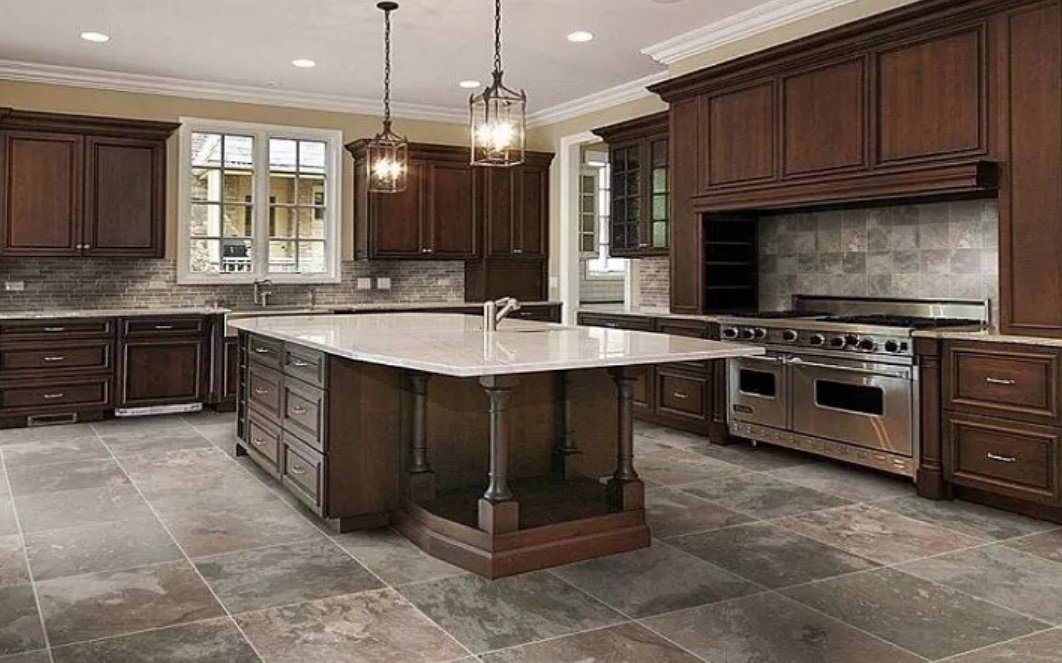Revamp your kitchen by adding beautiful floor tiles to create a stylish and functional masterpiece. Whether you want to enhance your kitchen’s look or increase its value, replacing the floor tiles can have a significant impact.
With a wide variety of tile designs, materials, and colors available, you can design a kitchen that reflects your personal style and stands out. The options range from modern and sleek to timeless and elegant, providing endless possibilities.
A new floor tile upgrade not only instantly refreshes your kitchen’s appearance but also offers practical benefits. These durable and easy-to-clean tiles are perfect for high-traffic kitchen areas, able to withstand daily cooking activities, spills, and accidents.
Investing in new floor tiles for your kitchen is an investment in both style and functionality. Don’t settle for a bland kitchen when you can have a space that showcases your unique taste and enhances your home’s overall appeal. Enhance your kitchen’s aesthetic today with stunning floor tile replacement.
Understanding the impact of floor tiles on the overall aesthetic
The floor is a prominent and influential element in any kitchen design, serving as the foundation for the entire aesthetic. Floor tiles play a crucial role in shaping the overall look and feel of the space.
When chosen thoughtfully, floor tiles can instantly elevate the kitchen’s aesthetic, creating a cohesive and visually appealing environment. The right tile can complement the existing color scheme, textures, and design elements, seamlessly tying the entire room together. Conversely, outdated or mismatched tiles can detract from the overall aesthetic, making the kitchen appear dated, disjointed, or lacking visual harmony.
Investing in high-quality, visually appealing floor tiles can have a transformative effect on the kitchen, instantly refreshing the space with a sense of modernity, elegance, or rustic charm, based on the chosen style. The versatility of floor tiles allows homeowners to experiment with different patterns, colors, and materials to create a truly unique and personalized kitchen design.
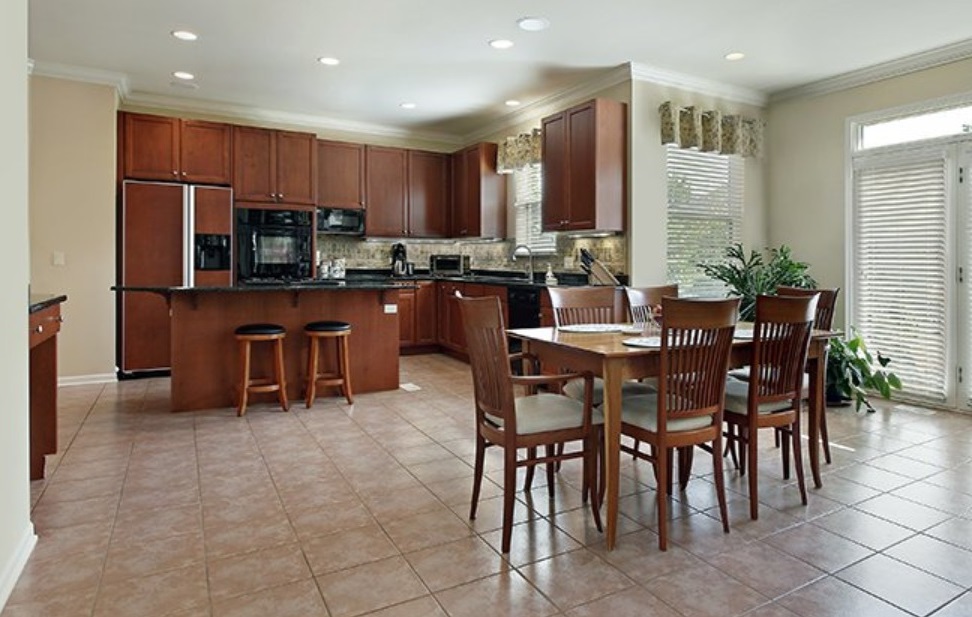
Enhance Your Kitchen’s Aesthetics with These Beautiful Kitchen Floor Tile Designs
Design, decor, texture, and layout are all crucial in a high-traffic area of the home. If you don’t use the right materials, the chances of your home aging gracefully are slim. This not only decreases your home’s market value but also puts people at risk of accidents. To avoid this, it’s important to choose kitchen floor tiles that can withstand your daily activities over time. So, how do you choose kitchen tiles that are practical and cost-effective? While there are numerous options, here are some durable kitchen tiles. Keep reading to discover the best kitchen floor tiles:
Linoleum
When people think of linoleum, they likely envision vintage-style interiors from the 1960s. While linoleum isn’t a new material, its popularity has waned as other types of kitchen flooring have become more favored. However, due to the cyclical nature of trends, linoleum has made a comeback and remains a popular choice for high-traffic areas such as kitchen floors. Made from natural, renewable materials, these tiles are environmentally friendly and easy to maintain, offering a cost-effective solution. Linoleum tiles exude a vintage feel and can help create a retro-style interior. To achieve a mid-century modern look, you can use linoleum flooring to complete the effect.
Hardwood
Hardwood is renowned as an excellent flooring option for interiors with high resale value. However, due to moisture issues, hardwood hasn’t been widely used in humid areas – until now. While wood is susceptible to water damage and mold, many types of wood can withstand these conditions. With a sealer, hardwood can be a great alternative to kitchen tiles. Wood floor tiles can be refinished and have a higher resale value. They are also softer and more comfortable to walk on than other types of tiles. Click-N-Lock tiles with a wood finish will keep your kitchen looking new for years to come.
Ceramic
Ceramic tiles are recognized for their suitability in moist areas like bathrooms and kitchens. They are also hypoallergenic, meaning they do not produce dust or cause allergies. This makes them a popular choice for floor tiles as they aid in maintaining a pollution-free kitchen. Ceramic tiles are not only hypoallergenic but also cost-effective. They are available in various styles to suit different budgets and needs.
Homogeneous Floor Tiles
Another excellent option for kitchen flooring is homogeneous tiles, a type of ceramic or porcelain tile. Unglazed porcelain tiles have a waterproof version. These tiles are easily identifiable due to the color being absorbed into the material rather than just on the surface. Additionally, homogeneous floor tiles are highly durable and possess anti-slip properties, making them ideal for homes with seniors or areas with high foot traffic. However, they are more expensive than cost-effective alternatives like vinyl and ceramic.
Concrete
Industrial style is not often associated with kitchen tiles, but exposed cement kitchen flooring can bring architectural consistency to every part of a home. While plain cement floors in the kitchen may not be everyone’s preference, they certainly add a personal touch to the interior! Many homes already have concrete floors that can be polished or stained to one’s liking. As a result, they are a more affordable option than ceramic kitchen floors. Concrete floors are a great way to introduce an industrial or modern ambiance.
Vinyl
Vinyl tiles are a fantastic choice for budget-friendly homes and make for great kitchen floors. Due to their durability, they offer long-term protection against spills or flood damage. If hardwood floors are not within your budget, vinyl is a great alternative as they come in a variety of shapes and styles at a fraction of the cost of hardwood floors. Vinyl tiles are low-maintenance and do not require extensive cleaning to retain their appearance. They are an inexpensive, do-it-yourself solution for low-budget home designs. During renovations, you can also lay vinyl over existing tiles for quick installation, saving money by reusing existing tiles.
Signs that it’s time for a floor tile replacement
Identifying when it’s necessary to replace your kitchen floor tiles is essential for preserving the space’s visual appeal and functionality. Several indicators suggest that it’s time for a floor tile upgrade:
Cracked, chipped, or damaged tiles: Over time, kitchen floor tiles can develop cracks, chips, or damage due to heavy foot traffic, dropped items, or natural wear and tear. These flaws not only detract from the overall appearance but can also pose a safety risk.
Discoloration or fading: Prolonged exposure to spills, cleaning agents, and sunlight can cause kitchen floor tiles to fade, discolor, or appear dull and lifeless. This can make the entire space feel outdated and unwelcoming.
Uneven or unstable surfaces: If the tiles have become uneven or unstable, it can create a tripping hazard and make the kitchen feel less unified. This may be a result of improper installation or underlying structural issues.
Mold or mildew growth: a health concern. In areas prone to moisture, such as bathrooms or basements, ceramic tile floors can be susceptible to mold and mildew growth, especially in grout lines. If you notice mold or mildew that continues to grow despite regular cleaning, it’s important to take action immediately. While cleaning and resealing the grout can sometimes solve the problem, extensive or recurring growth may require complete tile replacement to protect your health and prevent further damage.
Water damage or leaks: the underlying problem. If you have water damage or leaks under your tile flooring, it’s important to investigate the source and extent of the damage. In some cases, the tiles may need to be removed to address the underlying problem, giving you the opportunity to improve your flooring while addressing the water issue.
Outdated or outdated style: If your kitchen’s floor tiles no longer align with your personal style or the current design trends, it may be time to consider a replacement. Updating the tiles can instantly modernize the space and give it a fresh, contemporary look.
Being proactive in addressing these issues can not only enhance the kitchen’s aesthetics, but also improve its functionality and safety. By replacing worn or outdated floor tiles, you can breathe new life into the space and create a kitchen that truly reflects your personal style.
Factors to consider when choosing floor tiles for your kitchen
When choosing floor tiles for your kitchen, there are several important factors to think about to ensure a successful and visually appealing transformation.
Material: The selection of tile material can significantly affect the overall look, durability, and maintenance needs of your kitchen floor. Common choices include ceramic, porcelain, natural stone (like marble or granite), and luxury vinyl tiles (LVT). Each material has its own distinct properties, strengths, and visual characteristics.
Size and shape: The size and shape of the tiles can greatly impact the appearance and ambiance of the kitchen. Larger tiles can create a more seamless, minimalist look, while smaller tiles can add visual interest and a feeling of texture. Rectangular, square, or hexagonal tiles offer various design options to consider.
Color and pattern: The color and pattern of the tiles are crucial in establishing the atmosphere for the overall look of the kitchen. Neutral shades like white, gray, or beige can create a timeless and adaptable base, while more vibrant colors or elaborate patterns can make a strong statement. Consider how the tile color and pattern will complement the existing kitchen elements, such as cabinets, countertops, and backsplash.
Budget: If you are renovating your kitchen, you will also need to consider other expenses such as lighting, countertops, and cabinets, etc. So, ensure that the flooring plan fits within your budget. You can explore cost-effective kitchen flooring options and avoid settling for expensive flooring choices. It’s advisable to request cost estimates from at least three flooring companies. When looking for cost-effective flooring, alternative materials like luxury vinyl are worth considering. This flooring is available in a variety of colors and styles, making it a perfect alternative to wood flooring. While cost is an important consideration when updating your flooring, it’s best not to choose the cheapest option, as you may end up needing new flooring sooner.
Waterproof: Kitchen flooring should be waterproof as there is always a risk of water splashing on the floor. Therefore, regular wooden flooring is not a suitable choice for kitchen flooring. However, flooring types like porcelain or ceramic are very effective at resisting water. However, your choice of kitchen flooring should depend on the amount of water you anticipate in the area.
Slip resistance: In a kitchen, where spills and moisture are common, it’s essential to choose tiles with a high slip-resistant rating. This ensures the safety of your family and guests, especially in high-traffic areas. Look for tiles with a textured or matte finish for optimal traction.
Your Sense of Style: You need to take into account the choice of kitchen flooring that will complement your overall lifestyle. So, before selecting your kitchen flooring, decide on the design, feel, and color scheme that you desire. Choose a color that matches your walls, countertops, and cabinets. You can also consider other aspects such as the texture and pattern that you want. If you want the color of your kitchen flooring to be the focal point, you can consider bold black and white checkered tiles. Consider soft beige, gray, or off-white if you want a neutral backdrop. Regardless of the color and style you choose, ensure that you will not grow tired of it in the coming months or years.
Comfort: You may spend hours in the kitchen; therefore, you need to ensure that you have comfortable flooring. However, the softest materials, such as carpet, are not suitable for kitchen flooring, as they are too prone to stains and moisture. The right kitchen flooring material should combine comfort and cleanliness. So, when liquids spill on the floor, you should be able to wipe it off with a single swipe. Some comfortable kitchen flooring options can include cork, luxury vinyl flooring, sheet linoleum flooring, tile flooring, and rubber flooring.
Maintenance and cleaning: Kitchen floors are subjected to heavy use and frequent cleaning. Choose tiles that are easy to maintain, stain-resistant, and durable enough to withstand the demands of a busy kitchen. Some materials, like porcelain or natural stone, may require more specialized cleaning methods, so consider your personal cleaning preferences and habits.
By carefully considering these factors, you can select the perfect floor tiles that not only enhance the kitchen’s aesthetic but also provide practical benefits and long-lasting performance.
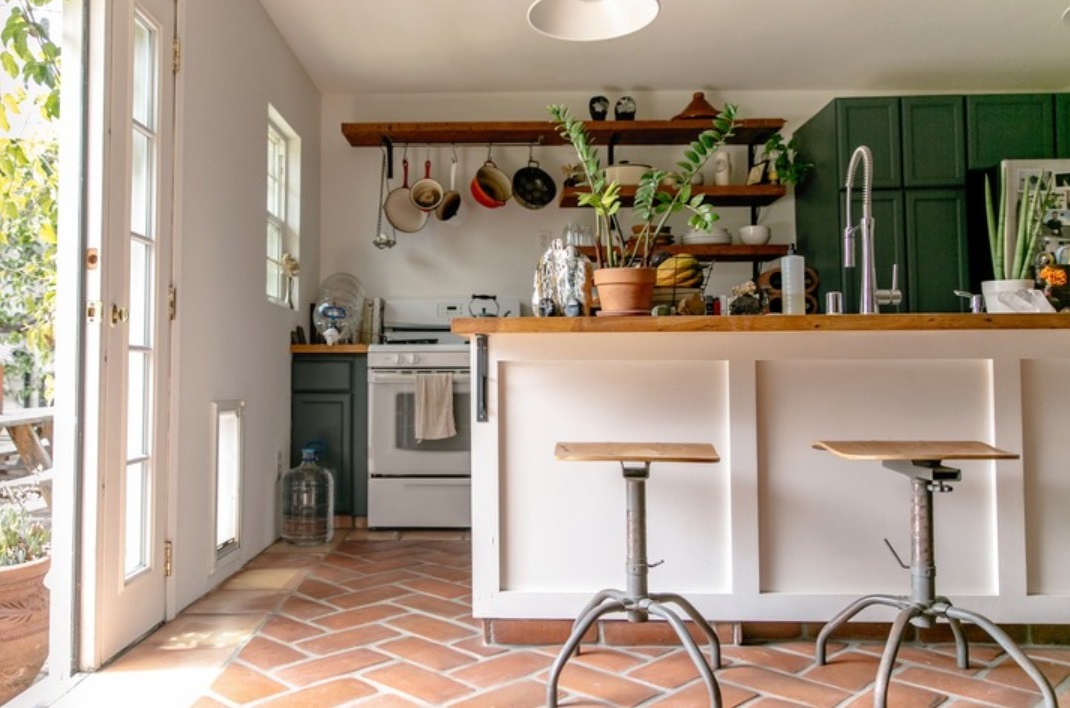
Popular floor tile options for a stunning kitchen aesthetic
When considering updating your kitchen’s look with floor tiles, there are numerous well-liked and visually appealing choices available. Each type of tile has its own distinct features, so it’s important to match your selection with your personal style and the overall design objectives for the space.
Ceramic tiles: Ceramic tiles are a timeless and adaptable option for kitchen floors. They are available in a wide range of colors, patterns, and finishes, from sleek and modern to rustic and vintage-inspired. Ceramic tiles are sturdy, easy to clean, and relatively affordable, making them a popular choice for many homeowners.
Porcelain tiles: Porcelain tiles offer increased durability and performance compared to traditional ceramic tiles. They are highly resistant to scratches, stains, and moisture, making them an excellent option for high-traffic kitchen areas. Porcelain tiles are available in various styles, including wood-look and stone-look finishes, allowing you to create a sophisticated and cohesive kitchen design.
Natural stone tiles: For a genuinely luxurious and timeless appearance, natural stone tiles like marble, granite, or limestone can elevate the kitchen’s aesthetic. These tiles feature unique veining, patterns, and textures that add depth and character to the space. Natural stone tiles are durable and can withstand the demands of a busy kitchen, but they may require more specialized care and maintenance.
Luxury vinyl tiles (LVT): Luxury vinyl tiles have become increasingly popular for their ability to replicate the look of natural materials, such as wood or stone, while offering enhanced durability and easy installation. LVT tiles are waterproof, scratch-resistant, and comfortable underfoot, making them an excellent choice for kitchen floors. They come in a wide range of designs and can be a cost-effective alternative to more expensive tile options.
Mosaic tiles: Mosaic tiles can be an excellent choice for kitchen floors, adding a touch of visual interest and a unique look. These small, intricately patterned tiles can create stunning focal points or accent walls, adding depth and texture to the space. Mosaic tiles are highly customizable and can be used to seamlessly complement the overall kitchen design.
By exploring these popular floor tile options, you can find the perfect solution that aligns with your kitchen’s aesthetic, your personal style, and your practical needs. Experiment with different materials, colors, and patterns to create a truly unique and visually stunning kitchen floor.
How to properly prepare for a floor tile replacement project
Embarking on a floor tile replacement project in your kitchen can be an exciting and transformative endeavor. However, to ensure a successful and seamless installation, it’s essential to properly prepare the space and follow a well-planned process.
Evaluate the existing floor: Start by thoroughly examining the current kitchen floor. Identify any underlying issues, such as uneven surfaces, cracks, or moisture damage, that need to be addressed before the new tiles can be installed. This will help you determine the necessary preparation steps and ensure a stable and level foundation for the new tiles.
Clear the kitchen: Before the installation process can commence, you’ll need to remove all furniture, appliances, and other items from the kitchen. This will provide unobstructed access to the floor and allow the installers to work efficiently. Be sure to carefully label and store any items that need to be removed to facilitate the reinstallation process.
Measure and plan the layout: Accurate measurements are crucial for a successful tile installation. Measure the room’s dimensions and calculate the required amount of tiles, allowing for a small surplus for cutting and wastage. Planning the layout is also important, as it helps you determine the starting point and pattern of the tiles. Consider using a chalk line to mark guide lines on the subfloor, which will help ensure straight and even tile placement.
Gather the necessary tools and materials: Make sure you have all the required tools and materials for tiling. This includes tiles, adhesive, grout, spacers, trowel, tile cutter, and level. Having everything ready before the installer arrives will help expedite the process and avoid delays.
Ensure proper ventilation and safety: Tiling can produce dust and fumes from the adhesive and grout, so ensure proper ventilation in the work area. Open windows and doors and use fans to circulate air. Also, keep children and pets away from the installation area to ensure their safety.
Remember to protect the surrounding areas: It’s crucial to minimize the impact of dust, debris, and potential spills during the tile installation process. Cover any cabinets, countertops, or walls that could be affected to keep your kitchen clean and prevent unintended damage.
Seek advice from professionals if you’re not experienced in tile installation. It’s highly recommended to consult with a professional tile contractor or flooring specialist. They can offer valuable guidance on tile selection, subfloor preparation, and installation techniques for your specific kitchen layout and needs.
Make sure to obtain necessary permits and approvals depending on your local building codes and regulations before starting a floor tile replacement project. Consult with your local authorities to ensure compliance and avoid potential issues during the installation process.
By thoroughly preparing your kitchen and collaborating with professionals, you can set the stage for a successful floor tile replacement project, ultimately transforming your kitchen into a visually appealing space.
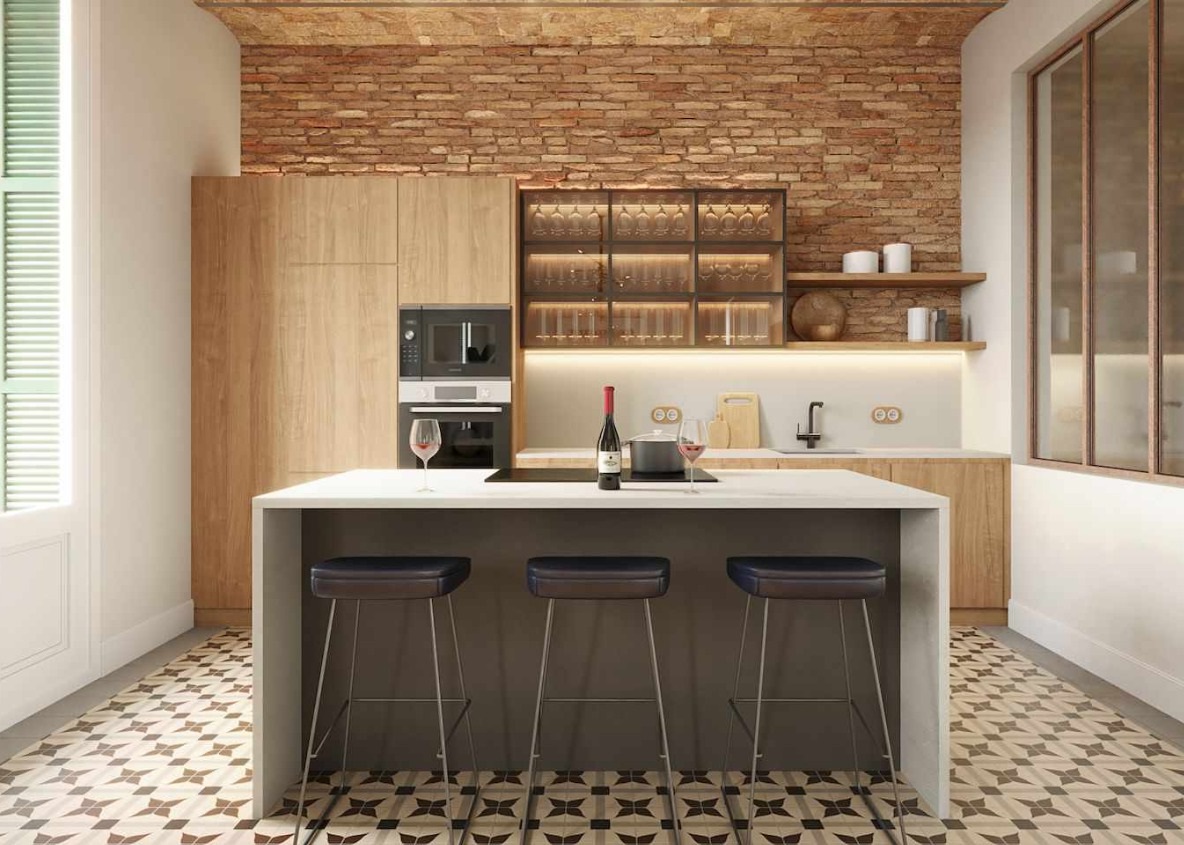
DIY vs. professional installation: Which is right for you?
Consider the DIY vs. professional installation options and choose the right one for you. When it comes to replacing the floor tiles in your kitchen, you have two main options: DIY installation or hiring a professional tile contractor. Each approach has its own advantages and considerations, and the right choice for you will depend on your skill level, available time, and budget.
DIY installation:
For homeowners with some DIY experience and a willingness to learn, a DIY floor tile replacement project can be a rewarding and cost-effective option. By taking on the installation yourself, you can save on labor costs and have the satisfaction of creating a custom, personalized kitchen floor. However, it’s important to understand the level of skill and effort required for a successful DIY tile installation.
Proper preparation of the subfloor, cutting tiles to fit around obstacles, and ensuring a level and secure installation are just a few of the critical steps involved. If not executed correctly, DIY tile installation can result in uneven surfaces, cracks, or other issues that can compromise the overall appearance and longevity of the new floor. Additionally, the time and effort required for a DIY project may be more than some homeowners are willing to invest.
Professional installation:
Hiring a professional tile contractor is often the preferred choice for homeowners who want a seamless and guaranteed installation process. Experienced tile installers have the necessary skills, tools, and expertise to ensure a high-quality, long-lasting floor tile replacement. They can also provide valuable guidance on tile selection, layout, and design to help you achieve your desired aesthetic.
- The main advantages of professional installation include:
- Expertise and experience in proper tile installation techniques
- Efficient and timely project completion
- Warranty or guarantee on the workmanship
- Adherence to building codes and regulations
- Proper disposal of old tiles and cleanup of the work area
The downside of professional installation is the higher cost, as you’ll be paying for the contractor’s labor and expertise. However, the investment can often be justified by the peace of mind and the assurance of a flawless end result.
When deciding between DIY or professional installation, consider your own skills, the complexity of your kitchen layout, and your budget. If you’re confident in your DIY abilities and have the time to dedicate to the project, a DIY approach can be a rewarding and cost-effective option. However, if you want a guaranteed, high-quality installation and don’t mind the additional cost, hiring a professional tile contractor may be the best choice for your kitchen floor tile replacement.
Tips for maintaining and prolonging the lifespan of your new floor tiles
Investing in new kitchen floor tiles is a great way to improve the look and functionality of your kitchen. However, to keep your new tiles looking great and lasting a long time, it’s important to follow proper maintenance and care practices.
Regular cleaning: Create a regular cleaning schedule for your kitchen floor tiles. Regularly sweep or vacuum the floor to remove dirt, debris, and grit that can cause abrasion and wear over time. For a deeper clean, use a mild, pH-neutral tile cleaner and a soft-bristle brush or mop to gently scrub the tiles, remembering to rinse the floor thoroughly. Avoid using strong chemicals or abrasive cleaners as they can harm the tile surface and grout.
Seal the grout: Properly sealing the grout between your tiles is crucial for maintaining their appearance and preventing stains, moisture, and damage. Apply a high-quality grout sealer according to the manufacturer’s instructions and reapply as recommended, usually every one to two years. This will help protect the grout from discoloration and deterioration, keeping your kitchen floor looking fresh and clean.
Address spills promptly: Spills and accidents are unavoidable in a busy kitchen. It’s crucial to address any spills or stains on the floor tiles as soon as possible. Blot the affected area with a clean, absorbent cloth and clean the tiles using a mild cleaning solution. Avoid letting spills or liquids sit on the tiles as they can seep into the grout and cause discoloration or damage.
Use floor mats strategically: Placing floor mats or rugs in high-traffic areas, such as in front of the sink or oven, can help protect your tiles from excessive wear and tear. These mats can absorb the impact of foot traffic and prevent dirt and grit from being tracked onto the tiles, prolonging their lifespan. Remember to clean and rotate the mats regularly to ensure they continue to be effective.
Polish Regularly: It is important to regularly polish concrete floors to prevent wear and tear. However, some floors can only be polished. This requires some technical knowledge, which you may need to learn. That is why it is highly recommended to hire the best commercial flooring services to polish your concrete floors. Also, if your floor is used frequently, it is advisable to polish it every 2 to 3 years. Polishing helps maintain the look and shine of your tile floor and prolongs its lifespan.
Use Furniture Pads: In many cases, furniture with sharp edges can cause scratches on the floor surface. Using furniture pads is a sure way to extend the life of your floor. Also, when buying furniture pads, consider the weight of your furniture. If you have heavier furniture, opt for thicker pads. This is an inexpensive but quite effective floor care tip.
Reseal or regrout as needed: Over time, the grout or sealant on your kitchen floor tiles may start to deteriorate. Keep an eye out for any cracks, crumbling, or discoloration and address these issues promptly by resealing or regrouting the affected areas. This will not only maintain the tiles’ appearance but also prevent further damage and ensure the longevity of your kitchen floor.
By following these maintenance tips, you can ensure that your new kitchen floor tiles will continue to look stunning and perform exceptionally well for years to come, enhancing the overall aesthetic and value of your home.
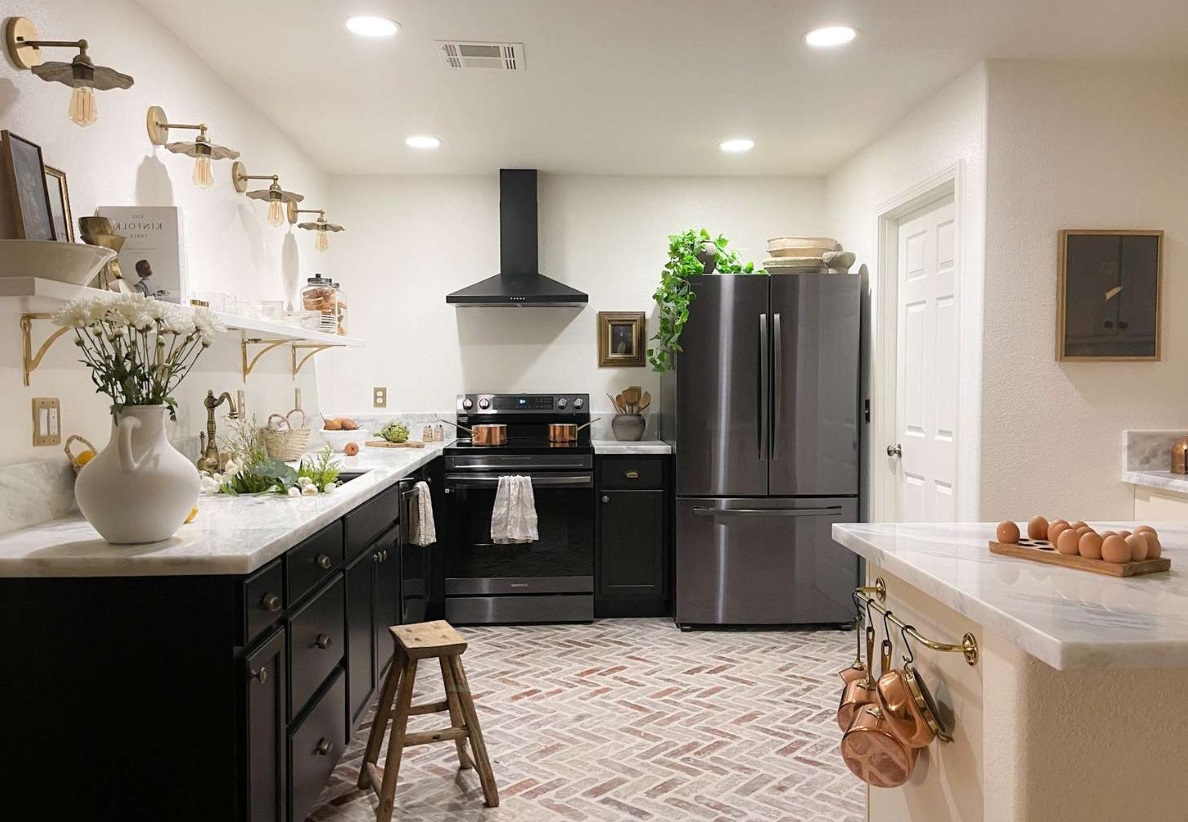
Enhancing the overall kitchen aesthetic with complementary design elements
Although the floor tiles are a central and influential aspect of your kitchen’s design, they are not independent. To truly enhance the visual appeal of your kitchen, it’s crucial to consider how the new floor tiles can be seamlessly combined with the other design elements in the space.
Cabinets and countertops: The cabinets and countertops in your kitchen play a significant role in the overall visual balance. Ensure that the colors, materials, and finishes of these elements harmonize with the selected floor tiles. For instance, if you’ve chosen a neutral, light-colored tile, consider matching it with white or light-toned cabinets and a compatible countertop material, such as quartz or marble.
Backsplash: The kitchen backsplash is another essential design element that can enhance the appearance of your new floor tiles. Select a backsplash material, color, and pattern that complements the floor tiles, creating a cohesive and visually appealing look. For example, if you’ve picked a bold, patterned tile for the floor, consider a simple, neutral backsplash to balance the design.
Lighting: Adequate lighting can significantly impact the overall look of your kitchen, including the new floor tiles. Thoughtfully placed task lighting, such as under-cabinet lighting or pendant lights, can help highlight the texture and colors of the tiles, while ambient lighting can create a warm and welcoming atmosphere. Experiment with different lighting options to find the perfect balance that enhances the beauty of your kitchen floor.
Furniture and decorations: The furniture and decor elements in your kitchen, such as stools, rugs, or artwork, can also contribute to the overall appearance. Choose pieces that complement the color, style, and material of your new floor tiles, creating a harmonious and visually appealing space. For instance, if you’ve chosen a rustic, wood-look tile, consider incorporating natural wood or earth-toned accents to unify the design.
By carefully considering the relationship between the floor tiles and the other design elements in your kitchen, you can create a unified and visually stunning space that reflects your personal style and enhances the overall appearance. The key is to strike a balance between the various design components, allowing the new floor tiles to stand out as the central focal point while seamlessly integrating with the surrounding elements.
Conclusion: Elevate your kitchen’s aesthetic with a floor tile replacement
Revamping your kitchen’s appearance with a striking replacement of floor tiles can be a game-changer, elevating the overall look and feel of the space. By understanding the impact of floor tiles on the kitchen’s design, recognizing the signs that it’s time for a replacement, and carefully considering the factors involved in selecting the right tiles, you can create a kitchen that truly reflects your personal style and enhances the value of your home.
From traditional ceramic and resilient porcelain to luxurious natural stone and innovative luxury vinyl tiles, the options for kitchen floor tiles are extensive and adaptable. By exploring these popular choices and aligning them with your design goals, you can transform your kitchen into a visually stunning and functional space that you’ll
